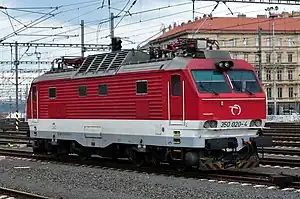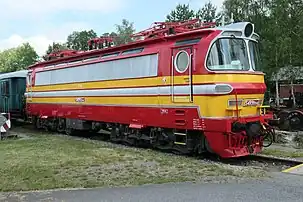| ČD ES 499.0 (pre-1988) ZSSK 350 (post-1988) Škoda 55E | |||||||||||||||||||||||||||||||
|---|---|---|---|---|---|---|---|---|---|---|---|---|---|---|---|---|---|---|---|---|---|---|---|---|---|---|---|---|---|---|---|
 ZSSK 350 020-4 at Praha hlavní nádraží, 2014 | |||||||||||||||||||||||||||||||
| |||||||||||||||||||||||||||||||
| |||||||||||||||||||||||||||||||
| |||||||||||||||||||||||||||||||
| |||||||||||||||||||||||||||||||
The ZSSK Class 350 (prior to 1988: ČSD Class ES 499.0) is an electric locomotive of the Železničná spoločnosť Slovensko (Slovak Railway Company) and previously of the Československé státní dráhy (Czechoslovak State Railways). Introduced in 1974, they became the first dual-system locomotives in Czechoslovakia, and have been used to haul express trains on the Bratislava - Prague railway corridor since then.
Between 1965 and 1975, express trains on the Prague - Bratislava main line were hauled by the E 499.1 (top) and S 489.0 (bottom) locomotives.
They are nicknamed "Gorilla" among railfans due to this locomotive being featured in 1989 on a postage stamp of Guinea-Bissau.
Accidents
- 28 June 1977: ES 499.0009 was hauling the southbound Meridian (Ex 271, Malmö to Bar) when it derailed shortly before 10 AM due to excessive speed (over 90 km/h (56 mph) in a 40 km/h (25 mph) zone enforced by railway signals) at the northern end of Bratislava hlavná stanica, overturning, hitting a retaining wall, an electric shunter (S 458.0004) of the station, before coming to a rest turned 180 degrees. The driver of the Meridian was killed after falling out of the locomotive and another 21 persons were injured. The locomotive had only travelled 312,828 kilometres (194,382 miles) at the time of the accident, and was eventually scrapped after a year and a half in service. The accident's causes are still unknown to this day due to the death of the train driver but he had unexplainably accelerated between Lamač and the tunnels just north of the railway station. The investigative committee and the railway workers eventually got involved in lengthy polemics in their attempts to find an explanation for the accident; the committee blamed the accident on the brake failiure while the railwaymen believed the cause to be something else.[1]
- 10 November 1989: 350 010 was hauling the northbound Balt-Orient (Ex 372, Bucharest to Berlin) when it passed a signal at danger and hit a local train (consisting of EMUs 460 081+082) from Praha-Holešovice to Děčín hl. n. from the rear, four minutes after midnight, at a speed of 116 km/h (72 mph), in Nové Kopisty. The accident led to 6 deaths and 58 injuries; the train was lightly loaded due to the fall of the Berlin Wall that had happened a few hours earlier. The locomotive was scrapped, along with the first 6 cars of the express train. The accident was caused by the poor functioning of the in-cab alerter system.[2]
- 23 January 2013: 350 011 was hauling the westbound Kriváň (IC 507, Košice to Bratislava hl. st.) when it hit a snowplow truck at a level crossing near Liptovský Mikuláš, leading to the death of a 50 year old train driver, Ján Šarudi. The locomotive was out in service for a year until it was repaired by ŽOS Vrútky and re-entered service in 2014.[3]
References
- ↑ TG8 (23 December 2008), Nehoda Expresu 271 "Meridian" v roce 1977 (in Czech), archived from the original on 9 October 2015, retrieved 14 March 2023
{{citation}}: CS1 maint: numeric names: authors list (link) - ↑ Rubeš, Václav (14 March 2023), "Balt-Orient expres '89: Tragédie zahalená v mlze revoluce (in Czech)", Železničář, retrieved 8 November 2012
- ↑ "Vlak sa zrazil s posypovým vozom, rušnovodic je mrtvy (in Slovak)". Teraz.sk. 14 March 2023. Retrieved 23 January 2013.
External links
This article is issued from Wikipedia. The text is licensed under Creative Commons - Attribution - Sharealike. Additional terms may apply for the media files.

